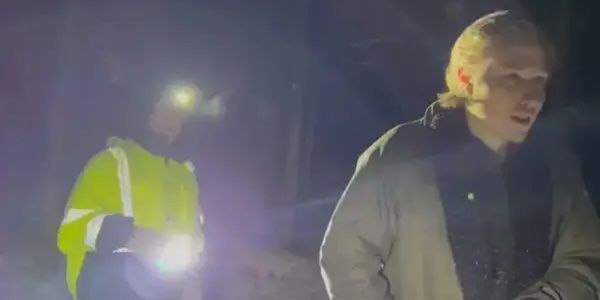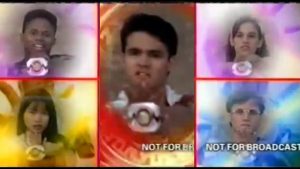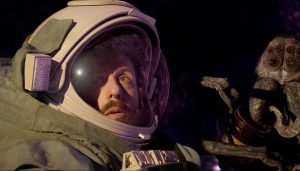
Marking the first widely distributed feature film release of director Lance Todd, Beyond the North Woods, a mind-bending found footage time-loop thriller for the extremely online generation, Film Inquiry met with the Minnesota native over a suitably glitchy Zoom to talk spacetime, Grand Theft Auto, and ultra-independent filmmaking.
Payton McCarty-Simas for Film Inquiry: The first thing I want to talk about is that this is not your first movie.
Lance Todd: No. It’s my fifth movie depending on how you count. I’ve made four movies that are all about an hour long to 70 minutes, and then one movie that’s 45 minutes. This movie, I looked at as kind of a restart. It’s found footage. I really liked how stripped-down it was. I kind of looked at it as the analog of filmmaking — it’s like going acoustic, basically. I’d just been doing something [different] for 10 years, and it felt really cool to try to approach it as if it were my first movie. Found footage horror seemed like a place where you could do anything you want, and people are wanting newer and different things out of it.
PM: Totally. So you said you were thinking about the process differently — how so? And are there thematic differences too, or were you just trying to find a different language for the same kinds of ideas?
LT: I think it was about trying to find a different language for the same ideas. Most of my movies deal with time as a major theme in some way. And at least half of them deal with a megalomaniac kind of character, someone who’s very ego-driven, who has addiction issues, alcohol issues. It wasn’t intentional — this movie was heavily improvised except for a loose outline, so a lot of it came from our subconscious.
There’s been this theme of recurring images in my movies: A lot of them [have] the same first and last image. I really like trying to structure a movie that way. And I was really interested to see how I could do that in found footage, because everything you’re doing in found footage has to be a character decision that was filmed. Every time you’re seeing something on screen, it means a character made a choice to film it. And so that was actually the initial challenge or puzzle that I created for myself: How could I get a recurring image, even though it’s found footage? How could I explore these characters? Once I started to solve these puzzles, then the movie just sort of revealed itself to us and became what it is.
PM: Was that what inspired this movie, the idea of the recurring image within found footage?
LT: I’ve always wanted to make a found footage horror movie. I’ve loved the genre forever, Blair Witch and Paranormal Activity, so I’ve always had it in my mind that once I have the right idea, I’m gonna make it. Fifteen years ago, me and my friends made a YouTube Paranormal Activity-style found footage thing. And it’s kind of funny… people thought it was real because [we] filmed it like it was just a vlog of [this guy’s] house being haunted or attacked. And people were like, “Dude, you have to call the police.” …
Found footage is so interesting to me, because I think it has this online or mainstream reputation as being — I don’t want to be insulting — sort of trashy horror, where it’s all just very low-budget, cheap scares, not a lot of big ideas, stuff like that. I was watching The Blair Witch Project when I was developing this, and I was thinking, “This reminds me of the French New Wave.” Someone left a Letterboxd review that was kind of negative, but it made me laugh because I liked it. They were like, “Wow, there’s a 10-minute shot of following behind two people’s heads. We never see their faces, what is that?” I’m like, “I love movies that do that!” That’s a lot of these European art films. There’s all these things you can do in the [found footage] genre that are more acceptable to a mainstream audience that I think are more niche outside of it.
Source: Tubi
PM: What caught my attention when I first saw Beyond the North Woods was that it’s one of those movies that feels really classic in that it’s simple and the premise feels clean, but it also feels wholly original within the found footage genre. I would love to hear more about the thing that makes this film original: the temporal question. You work a lot with time in your other films, and I’d love to know what it is that draws you to play with temporality? I’m also curious about how the internet relates — this movie is about a character who’s very online.
LT: I think of him as the embodiment of the worst of the internet. I grew up with classic 2009 YouTube where it was all just home creators, DIY. It wasn’t corporate at all, and it was like this special place. And then this evil thing started to emerge. I don’t think all influencers are evil or whatever, I have friends who do it, but there’s this replacement — for what used to be a place where you could just go discover things that people were doing on their own — to these mascots for the internet.
I really think this movie, in a large part, came from the pandemic, when I spent like a year on lockdown, just afraid of the world. I didn’t have a pod of people that I trusted or anything, I was just in my apartment for a year, and I was watching YouTube on loops, the same videos, the same music videos, the same sad songs. Time seemed to just freeze and stop, and it really felt like this purgatory. There’s this song by the band The Japanese House. And the lyrics are something like, “You’re stuck, you’re repeating yourself.” I would listen to that song every day.
This is the way algorithms work. [YouTube] Reels and TikTok and Instagram. I’m addicted to all of this stuff. It’s really bad on my brain, and so I constantly have this feeling that I’m stuck in a loop. And I think that feeling definitely was the motivation to get up and make another movie, [and] filmmaking is the perfect medium to explore time. It’s the Andrei Tarkovsky thing, who’s referenced in the movie, where he says, “Cinema is the art of sculpting time.” And found footage, I felt, was a good genre to really sculpt time in because every time you cut, that’s the character making the choice. So not only are you as a director and the writer trying to structure the audience’s time, but now you have to have it so the way they’re experiencing that time is decided by the character as well.
PM: Absolutely — one of my favorite film essays is called “Photogénie and the Imponderable” by Jean Epstein. It’s a similar thing where he describes time as the fourth dimension. It’s like a piece of poetry, I love it. But I’d like to back up and talk about how you got started making films.
LT: I really think it’s as simple as when I was really young, I saw my dad holding the family camcorder, and I just wanted to do that. So I was making shorts and videos from when I was, like, 5 years old, with this giant camera that was the size of me, VHS, and it was just a hobby. Literally, since I was born, there’s just been an urge to yap at people and tell them stories, even if I have nothing to say.
And when I turned 18, I was failing high school, I had a 1.1 GPA, and I had to figure out where I was going to college. And I thought, “Well, I have to go to film school because I’m not getting in anywhere else. I guess I’ve cornered myself into the dream, I have no option but to chase it.” That’s kind of been my strategy for a decade. I got started making shorts with my family and friends, and then I moved to Los Angeles for film school [at the Los Angeles Film School] and took it seriously.
PM: I know that the people in Beyond the North Woods are friends of yours, so I’d love to know about the process of casting this movie and working on it in that communal way.
LT: Yeah, all my friends who I worked on this movie with were not my friends before I started making movies. These were people I met while we made [my first four] movies, and we all have a very, very established working dynamic. My very first movie, we actually did a full casting call because I didn’t know anyone. Now we know everyone. We just know each other so well. We know our strengths. That’s a big part of how I develop these projects, too, is looking at what’s immediately available in front of me right now: “Who’s in town, who’s doing what? What objects, what sets, what locations, what weather do we have?” All of that comes into play when we’re developing stuff.
The process for [Beyond the North Woods] was a very refined version of what we’ve been doing before. When I’d make a movie, I’d write the script, or I’d write half a script or half an outline, and then I’d call my actor friends and say, “Let’s just start shooting stuff, see what happens.” It would take two years to make a movie, three years sometimes, because we’d just be exploring it and have to spend a month to find an actor who’s right for a part or something, and then film when the weather was right. So it was all very loose, and this [shoot] was a very fast version. Once I decided that I wanted to make this movie, I made, like, three phone calls and had the whole cast. We just had established a network. We were ready to go.
That’s when life feels timeless in a good way, is when I’m on a set with my friends and we’re filming and no one’s thinking about going home, no one’s thinking about anything outside of it, we’re just in this fiction we’ve created for ourselves. And it’s the realest feeling thing ever.
PM: In terms of your cast, I was really curious about Matt Rasmussen, who plays Elijah. It’s a small cast, but he has a different energy than you guys, it’s really striking. How did you meet him?
LT: I love Matt. He’s the goofiest, nicest guy I’ve ever met. He’s known as “The King of Halloween” locally. He’s at every party. He’s wearing crazy costumes. He’s just someone I’ve known about locally for like, seven years, and we’d always talked about making something together.
His personality and his presence really influenced this movie, his character of Elijah, who is the main villain. He was not the main villain when we started shooting. It was going to be about this biblically accurate Angel/Mothman creature. But as I was doing the tests, and as he was just riffing and talking about stuff near me, I just had this realization after two days of shooting, like, “This has to be about you. It’s got to be about the human. I just want to see more of your face in this vertical close-up.”
Source: Tubi
I think he made the movie work. The very first time we talked about making this movie, we were playing laser tag, and I didn’t have anything to make, and I was just struggling. I just blurted out to him, like, “We need to make a Bigfoot movie or something! Anything!” And he was just like, “Yeah, buddy, let’s do it.” And so we just started thinking and writing, and this movie came out of it. It’s obviously not a Bigfoot movie, but that was the very first thing that kind of got this development track happening.
PM: Are there any other filmmakers, or perhaps — though I cringe to use the phrase “content creators” — creators who inspire your work and whose work you follow, or who you take lessons from?
LT: I think two come to mind for this movie specifically. [The first is] this YouTuber, Joel Haver. He did what I did. He made four or five independent movies, put them on YouTube. They did okay. And then he pivoted to the 2009 YouTube sketch style comedy. He started making sketches with his friends, and they started blowing up. And he used that to draw an audience back to his movies. He’s got millions of subscribers now, he’s gotten big Hollywood offers, and he just says, like, “I don’t want to do that. I want to make movies with my friends. I don’t need to make money.” I don’t think I’d go the same way as him, but he has such an independent spirit, and he likes working low to the ground.
Then there’s a video game called The Stanley Parable, and [that] was really inspiring to this movie. The game is a walking simulator where there’s no interaction your character can do. It’s really about determinism. The game starts with you standing in front of a left door and a right door, and a narrator says, “Stanley walked through the right door,” and then you get to choose whether you follow the narrator or not. And then the game gets really meta and spins out of control and goes way deeper than you’d think it would: You go through the left door, and then the narrator starts arguing with you and getting mad at you, and he tries to push you back on track for the story. [That’s] obviously there in Beyond the North Woods. And I think that is why the time travel stuff is there. I’m trying to explore determinism, and if the choices we make are really ours, and how context and cause and effect shape who we are and what we become and the loops we find ourselves in.
I love the idea of trying to look at video games for inspiration, too, and trying to bring things in from that to film and vice versa. I was getting frustrated with video game movies. I love The Last of Us, but there’s a cowardliness in every video game project where they don’t want to make it like a video game at all. And I was just–– this is a total tangent–– but I was daydreaming about, like, if I ever got to make the Grand Theft Auto Movie. If you did it with courage, you’d have the two characters on a date having a casual conversation driving down the street, and then just pedestrians are flying off the windshield and the bumper and no one’s acknowledging it.
PM: That’s awesome. It’s sad the way fandom and commercialism subsume these things. It’s very strict in its rules. So how do you think that kind of internet troll-like dynamic plays into your character, Paul, in Beyond the North Woods?
LT: He was heavily inspired by Logan Paul, not in the way he looks or speaks, but just what he is and what he stands for. There’s that Logan Paul video where he goes out to the Japanese forest [Aokigahara], the “suicide forest,” and he filmed a corpse. To me, that was such an absurd moment in our culture. I feel like it’s not new, you go back hundreds of years, you’ll find people exploiting the dead for money, you know. But it really shows what the internet grew into. All of the worst possible things that get attention in real life are now for billions of people all at once right away. There is no respect, there is no dignity, there is only content.
But the characters I play in my movies are also really just heightened versions of different aspects of my personality, I guess. Like this Paul character is not who I act like in real life, but if I have a few beers and I’m playing video games with my friends and we’re trolling, that’s how I’m talking to people. I’m just a huge asshole. There was a year during the pandemic where we would play video games every night, and when I’d log in, I’d be like, “What is up, guys? How’s it going?” Just to make fun of all this YouTube stuff we were watching, it wasn’t even for the character. And I think that’s where the character was developed, from video game trolling. I think that’s how I worked on my improv.
Source: Tubi
PM: So fair, so fair. I’d love to hear more about your local film scene [in Duluth, Minnesota].
LT: My dream in life was to have Duluth, Minnesota, become a [film] place. Ever since I was little, I would talk about it like, “We’re gonna make big movies here.” And I moved to Los Angeles for film school for two years, and I was miserable, and I hated it. When I lived there, I tried to make an indie movie. We had access to this rental room, we have access to all these facilities in the school, we have our houses, we have the streets of LA. We can make a movie. And I was so bummed, because I wrote a movie, and I got all my friends to agree to it, and then they just never wanted to make it. The culture out there really seemed like and — it’s not everyone — but it really seemed like a lot of people wanting to talk about making something and then not making it. It was all branding.
Everything I wrote when I lived in Los Angeles took place in Duluth. So when I moved back here, I was like, “I have to start making movies here right away.” This is just where I’m inspired. These are the people that inspire me. And then over the years, other people started making their own indie movies here, and this little scene developed where the actors who would be on my movie would direct a movie next, and I’d be in their movie, and we all just sort of took turns for like seven years, just jumping between each other’s productions, just helping out however we could. And then this film scene caught the attention of a couple organizations. They saw that we had a successful film festival in Duluth, we had a successful grant organization, we have a thriving scene here.
And then they started an initiative, which I worked on, to get tax rebates and tax incentives for bigger productions to shoot here. It’s mind blowing to me: When I lived in Los Angeles, I said, “I want there to be real studios in Duluth. I want there to be real productions.” And then my job was to attract them here, and I got to go work on those movies. I got to be a camera operator on a Lifetime movie, and I got to be a PA on a Hallmark movie. It’s been amazing.
PM: To go back to the movie and this character, whose egomania is driving him into a dystopian hellscape: If we’ve been talking about predestination and art… can he escape that fate? Would it be possible for him?
LT: Yeah, that’s maybe the deepest question there is: Can we get out of our own fate? You know, Shakespeare wrote about it. Everyone thinks about it. I like to hope we live in a world of forgiveness and growth, and at least personally, I need to believe that’s real. But at the same time, I feel like it’s a utility belief where I don’t really believe it. You see a Logan Paul type, you see my character in the movie, you see like a Kanye West kind of person. Every incentive around them is telling them to keep being this way. It’s telling them to keep being this maniac, to keep going all in on ego, to keep saying what you’re saying. They’re getting financially rewarded, they’re getting attention, they’re getting controversy, and it’s all working out for them in the end in one way or another. And so, I don’t know, I look at that context, and the context would have to change. For them to change, our culture would have to be different.
Beyond the North Woods is available to stream on Tubi.
Does content like this matter to you?
Become a Member and support film journalism. Unlock access to all of Film Inquiry`s great articles. Join a community of like-minded readers who are passionate about cinema – get access to our private members Network, give back to independent filmmakers, and more.





